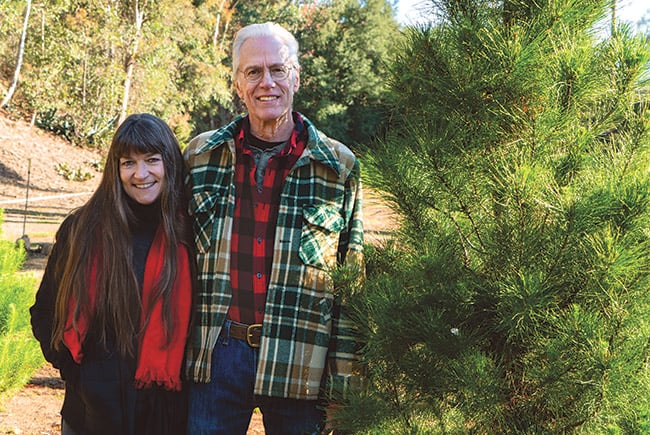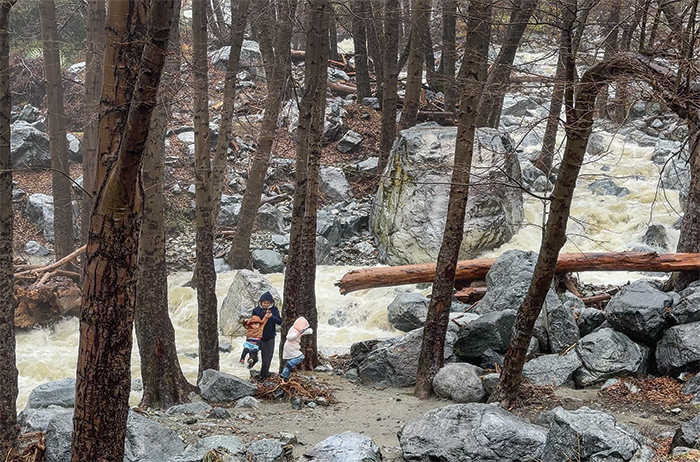Brock Christmas Tree Farm has deep roots

by Mick Rhodes | mickrhodes@claremont-courier.com
In 1961, shortly after buying a nearly two-acre lot in what was then mostly wide open north Claremont, René Brock planted an Italian stone pine.
It remains there today, now 50 feet tall. Its oddly shaped canopy and massive trunk serve as a reminder of the decades that have passed mostly unchanged at Brock Christmas Tree Farm, and in stark contrast to the aggressive development Claremont has seen over that same period.
René’s son David Brock was seven in 1961.
“That tree was planted in the first year or two, with the intention of pruning it and turning it into a Christmas tree,” said David. “And it got bigger and bigger and nobody decided to do anything with it, and then we realized it was sort of a picturesque tree, and that’s where it is now, a huge tree that takes up a lot of sunshine.”
Brock grew up playing at the farm and working the land with his father. He helped ferry water from his family’s Claremont home up to the property prior to municipal water service. When René died in 2002, he took over the farm’s care and feeding. He, along with his partner of 23 years Rebecca Hamm, and his sister Bonnie Brock, are now the co-owners of Brock Christmas Tree Farm.
Though gone nearly 20 years, his father’s presence remains in many ways, not the least of which in the massive pine that stands sentry in the middle of the lot.
“We periodically trim it a little bit, because it really casts a pretty big shadow,” Brock said of the huge sapling, seemingly unaware (or maybe not?) of the wonderful metaphor.
I asked him about the symbolism of that tree.
Throughout “the whole property I feel like I’m communing with dad, because his footsteps were all over it, the perimeter, that big tree, up on the slope, some of the stakes that he liked to paint white for staking trees up, they’re still around. So yeah, there’s a lot of his hand all over the property.”
At Brock farm there are exactly zero inflatable holiday decorations. You won’t see carolers, complimentary hot chocolate or hear piped in holiday music on an endless loop. It’s quiet up there. Peaceful. Meditative even.
Visitors stroll the small grove of pines and cypress, make their choice and cut their tree themselves. That’s what drew me and my 11-year-old son Everett last Saturday.
Brock showed us around the farm, pointing out the varieties and recalling 60 years of family history there. Everett found a nice six-foot pine. Brock got him started with a guide cut, then handed him a small hand saw.
In today’s ultra-litigious society, it’s reassuring that something so tied to the earth as felling a tree is still available to kids without an adult’s signature on a multi-page release of liability. As a man of a certain age, I appreciate the nostalgia.
“Well, I do tell people to be careful, the saw is sharp,” Brock said. “I haven’t had any saw accidents though.”
Everett loved it. And I relished it too; finding a new outdoor experience for us to enjoy together that doesn’t cost half a week’s salary — especially with a typical screen-obsessed 11-year-old — is a major win any parent.
The prices are more than competitive, with the best tree on the lot costing just $59.95. The average tree at Costco or Home Depot will run you between $90 and $110. And Brock will cut trees for the non-lumberjack inclined among us, so I say why bother with the big box stores?
Folks new to the farm are often struck that it seems to be hidden in plain sight, just across the wash from the heavily trod Thompson Creek Trail at the crosswalk on Mountain Ave.
It’s also remarkable the property has remained somewhat wild, even as it has become surrounded on all sides by sizable single family homes over the past 60 years. Critters of all kinds traverse it, and a full-sized black bear has been visiting once or twice a week for 15 years, often leaving hair and claw marks on the trunks of various trees it scratches up against, Baloo the Bear style. Sometimes the trees don’t survive the ursine assault. The ones that do then have to be pruned and usually held over for the following year after they heal up from their bear encounter. It’s an annoyance for sure, but one that Brock endures good-naturedly.
He’s willing to “give up a couple of trees to the bear, but there was a time when he was just hitting randomly — all nice trees by the way too.”
The bear-altered trees aren’t always bad news though.
“I say, ‘Yep, that’s what the bear did.’ And sometimes it leaves a few bear hairs on the tree. Sometimes people choose a tree specifically because of that.”
Take that, Home Depot. Bear hairs: another down-to-earth premium not available at big box chain stores.
“It’s the bear seal of approval,” Brock said with a laugh.
The cut-it-yourself tree farm is not the only throwback here. Though he is now a master gardener, Brock’s horticulture knowhow was accumulated the old-fashioned way.
“It was hard work and trial and error, figuring out what went wrong and then trying to do it right the next time,” he said.
He’s now getting into stem propagation, or taking cuttings from existing trees and rooting them in a tightly controlled environment. Leyland cypress is one of the trees he grows this way.
“The basic cypress you can grow from seed, but some of the more desirable cultivars are only grown by cuttings,” he said.
A typical crop starts with about 75 one-year-old seedlings. They grow on the property for three to five more years before they’re ready for market.
In a real rarity for any business, any product at Brock Christmas Tree Farm that does not sell this season is only worth more next season.
“The following year we’ll have an even bigger tree,” Brock said. “It might not always look as prime as one of the premium trees, because they get older and they get a little more raggedy looking, but yes, they continue to grow.”
The farm is open Saturdays and Sundays from 9 a.m. to 4:30 p.m. There’s talk of opening Fridays as well, perhaps next year.
Brock will plant 160 seedlings this winter, and is looking to expand the farm in years to come. The hoped for bumper crop will, with luck and care, begin to mature to Christmas tree size in 2024 or 2025.
“Yeah, there’s going to be a lot of trees in a few years,” he said.
That abundance will surely make a lot of local families’ holidays brighter, as well as a certain bear’s.








0 Comments